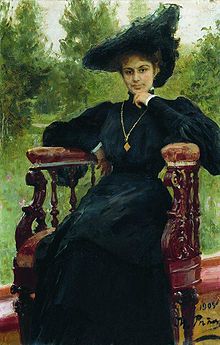- Maria Andreyeva
-
Maria Fyodorovna Andreyeva (Russian: Мари́я Фёдоровна Андре́ева, Mariya Fyodorovna Andreyeva) was the stage name of Maria Fyodorovna Yurkovskaya (Мари́я Фёдоровна Юрко́вская) (July 4, 1868 – December 8, 1953), a Russian/Soviet actress and Bolshevik administrator.
Between 1918 and 1921, she was Commissar of Theaters and Public Shows in Petrograd. Between 1931 and 1948, she was Director of the House of Scientists in Moscow.
She had been the common law wife of writer Maxim Gorky since 1903.
She had been characterized as one of the two most powerful people in Soviet theatre, if only for a short time.[1]
Her father, Fyodor Alexandrovich Fyodorov-Yurkovsky (Фёдор Александрович Фёдоров-Юрковский, 1842–1915) was the director of the Alexandrinsky Theater, and her mother was an actress. She followed into the steps of her parents. After drama school she went to Kazan, aged 18. She married her elder by 18 years, Andrey Zhelyabuzhsky, controller of the Kursk and Nizhny Novgorod railroads, but who was also involved in theatre. The couple had two children, Yuri (1888–1955) and Yekaterina (born 1894). Yuri went on to become a film director.
After Zhelyabuzhsky received a new post, the family moved to Tbilisi, where she had success as an actress. They next moved to Moscow, where Andreyeva worked with Konstantin Stanislavsky at the Moscow Art Theatre. She made her Moscow debut on December 15, 1894. She enjoyed great success.
Andreyeva took an interest in Marxist literature and she secretly joined the Russian Social Democratic Labour Party. In 1902, she decided to leave acting. In 1900, she had met for the first time Maxim Gorky in Sevastopol.
Gorky and Andreyeva travelled to the United States, then moved to Capri in Italy.
Already by 1914, she was active in attempts to promote classical theatre to the masses. Only after the October Revolution did these endeavours bear fruits. She was instrumental in the establishment of the Bolshoi Drama Theater, which opened in 1919. In January that year, Anatoly Lunacharsky nominated her as his deputy in his role of head of art section of the Narkompros in Petrograd. The Petrograd Soviet refused to confirm her nomination, but Vladimir Lenin intervened in her favour and the appointment went ahead.
In 1920, Lunacharsky offered her the position of head of TEO, the theatre department of Narkompros, in Moscow, but she refused.
In the 1920s she separated from Gorky.
It is thought that she was the model for the character of Margherita in Bulgakov's novel The Master and Margherita.
References
- ^ Leach, Revolutionary Theatre, p.27
- "Maria Fedorovna Andreeva Biography" (in Russian). http://www.peoples.ru/art/theatre/actor/andreeva/index.html. Retrieved 2008-07-12.
- Fitzpatrick, Sheila (1970). The Commisariat of Enlightenment: Soviet Organization of Education and the Arts under Lunacharsky. Cambridge University Press. ISBN 0521524385.
- Leach, Robert (1994). Revolutionary Theatre. Routledge. pp. 27. ISBN 0415032237.
- Clark, Katerina (1995). Petersburg, Crucible of Cultural Revolution. Harvard University Press. pp. 101, 103, 107, 110–111. ISBN 0674663365.
Categories:- Russian stage actors
- Soviet stage actors
- 1868 births
- 1953 deaths
Wikimedia Foundation. 2010.

